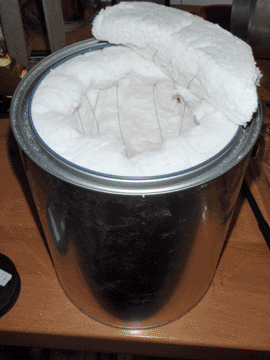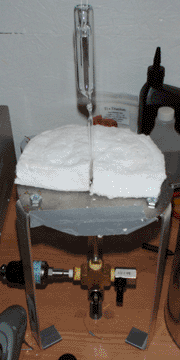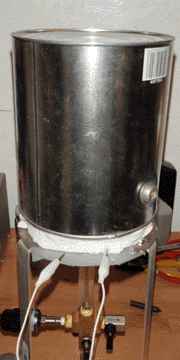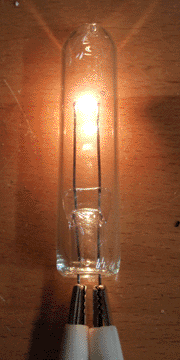



To improve the longevity of any vacuum tube, an oven is required to "bake out" any gases trapped in the glass or in the tube components. I made one by lining a paint can with 1 inch thick ceramic wool, where the wool had resistance wire stitched through it in a zig-zag pattern. A variac is used to control the power. There is no thermostat or temperature controller, so temperature settings are very vague. For now this is fine, as I only needed it to be "very hot, but not glass-melting hot". With a temperature controller it could double as an annealing oven though, so I might add one in the future. The oven sits on a stand made from spare parts. A hole has been drilled in the center of the stand to allow the evacuation stem of a tube to fit through.
I used the oven when making a light bulb, which can be seen above. I manually ramped the power up to around 200W over the course of 30 minutes, then ramped it back down for 30 more minutes. At this point I believed the tube was cool enough to not be thermally shocked by the ambient air, so I removed the oven and lit the filament to drive any air out of it, then sealed the tube. The bulb works well, and I will test it periodically to see if the bakeout oven helped. Of course, the real test will be when I make another diode, as contaminants have a much greater effect there than in a light bulb.
I have used the bakeout oven many times since this was written, and now have a better idea of its characteristics. I measured the resistance of the heating element (a length of 28AWG Kanthal wire) to be 50 ohms. When powered with 60 volts AC from my variac, it produces about 70W of heat. This is the maximum safe power for baking out a tube. Beyond this point, the glass tends to soften and melt if the power is maintained for any length of time. The success of the first light bulb was probably due to my estimate of 200W being significantly off (I ran the oven briefly at 130W), as well as the short duration of overheating (around 5 minutes). When running at 70W, the outside of the can reaches a stable temperature of around 85 degrees Celsius. This is hot, but not dangerous. The paint can has held up well and the plastic lining inside it has not smoked or burned. I have also shortened the legs to bring the base of the oven closer to the vacuum manifold. The original legs were too long and required each tube to have an 8 inch evacuation stem, which was excessive.